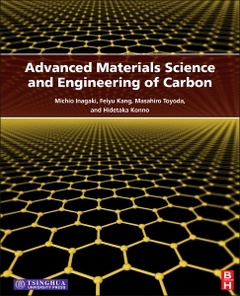Advanced Materials Science and Engineering of Carbon
Auteurs : Inagaki Michio, Kang Feiyu, Toyoda Masahiro, Konno Hidetaka

Carbon materials are exceptionally diverse in their preparation, structure, texture, and applications. In Advanced Materials Science and Engineering of Carbon, noted carbon scientist Michio Inagaki and his coauthors cover the most recent advances in carbon materials, including new techniques and processes, carbon materials synthesis, and up-to-date descriptions of current carbon-based materials, trends and applications.
Beginning with the synthesis and preparation of nanocarbons, carbon nanotubes, and graphenes, the book then reviews recently developed carbonization techniques, such as templating, electrospinning, foaming, stress graphitization, and the formation of glass-like carbon. The last third of the book is devoted to applications, featuring coverage of carbon materials for energy storage, electrochemical capacitors, lithium-ion rechargeable batteries, and adsorptive storage of hydrogen and methane for environmental protection, photocatalysis, spilled oil recovery, and nuclear applications of isotropic high-density graphite.
Introduction
- Carbon nanotubes: synthesis and formation
- Graphene: synthesis and preparation
- Carbonization under pressure
- Stress graphitization
- Glass-like carbon: its activation and graphitization
- Template carbonization: morphology and pore control
- Carbon nanofibers via electrospinning
- Foaming of carbon (including exfoliation)
- Nanoporous carbon membranes
- Carbon materials for electrochemical capacitors
- Carbon materials in lithium-ion rechargeable batteries
- Carbon materials in photocatalysis
- Carbon materials for spilled heavy oil recovery
- Carbon materials for adsorption of molecules and ions
- Highly-oriented graphite with high thermal conductivity
- Isotropic high-density graphite for nuclear applications
Conclusions
Feiyu Kang received his PhD from The Hong Kong University of Science and Technology in 1997. He is honorary editorial advisory board of international journal CARBON, Joint Chairmen of international symposiums: CARBON2002 (Beijing), Carbon2011 (Shanghai) and 15th International Symposium on Intercalation Compounds (ISIC15), Coordinators of international research projects: Professor M. Inagaki (NSFC-JSPS) and Professor I. Mochida (JST-MOST).
Prof. Kang has investigated graphite and carbon materials since 1988. His research interest includes nano-carbon materials, graphite producing process, porous carbon and nuclear graphite. Prof. Kang had published more than 200 scientific papers and 3 books.
- A progression from synthesis through modern carbonization techniques to applications gives you a thorough understanding of carbon materials
- Covers a wide range of precursor materials, preparation techniques, and characteristics to inspire your own development of carbonization techniques, carbon materials and applications
- Applications-oriented chapters include timely content on hot topics such as the engineering of carbon nanofibers and carbon materials for various energy-related applications
Date de parution : 11-2013
Ouvrage de 440 p.
19x23.3 cm
Thème d’Advanced Materials Science and Engineering of Carbon :
Mots-clés :
Adsorption; CO2 reduction; CVD; Capacitor; Carbon foams; Carbon materials; Carbon membrane; Carbon nanofibers; Carbon nanotubes; Carbonization; DEO benchmark; Glass-like carbons; Graphene; Graphitization; Highly-oriented graphite; Isotropic high-density graphite; LiFePO4; Lithium-ion rechargeable batteries; MgO; Photocatalysis; Spilled-oil recovery; Template carbonization; TinO2n-1; TiO2; W18O49; activation; adsorbent; air-oxidation; applications; arrays; asymmetric capacitor; block copolymer surfactant; blowing; built-up pressure; carbon coating; carbon doping; carbon families; carbon spheres; carbon/carbon composite; carbonized fir fibers; catalytic acceleration; charge/discharge performance; cleavage; cold isostatic pressing (CIP); composite X-ray diffraction profile; cycle performance; diamond-like carbons; electrical conductivity; electrolyte solution; electromagnetic wave absorption; electrospinning; energy storage; exfoliated graphite; exfoliation; forests; fusion reactor; gas separation; graphite; graphitization; heavy metals; heavy oils; high temperature gas-cooled reactor; highly-oriented pyrolytic graphite (HOPG); hydrogen; hydrothermal; melting; mesophase-pitch based carbon fibers; metal loading; metal-organic framework; methane; microtexture; morphology control; nanotexture; organic molecules; organic synthesis; performance rating; pitch impregnation; polyimides; pore control; pore structure; pore structure control; pressure; sensor; sheets; silicas; sintered diamond; sorption capacity; sorption/desorption cycle; spheres; stress graphitization; structure; symmetric capacitor; template carbonization; unzipping; visible-light sensitive; webs; yarns; zeolite



